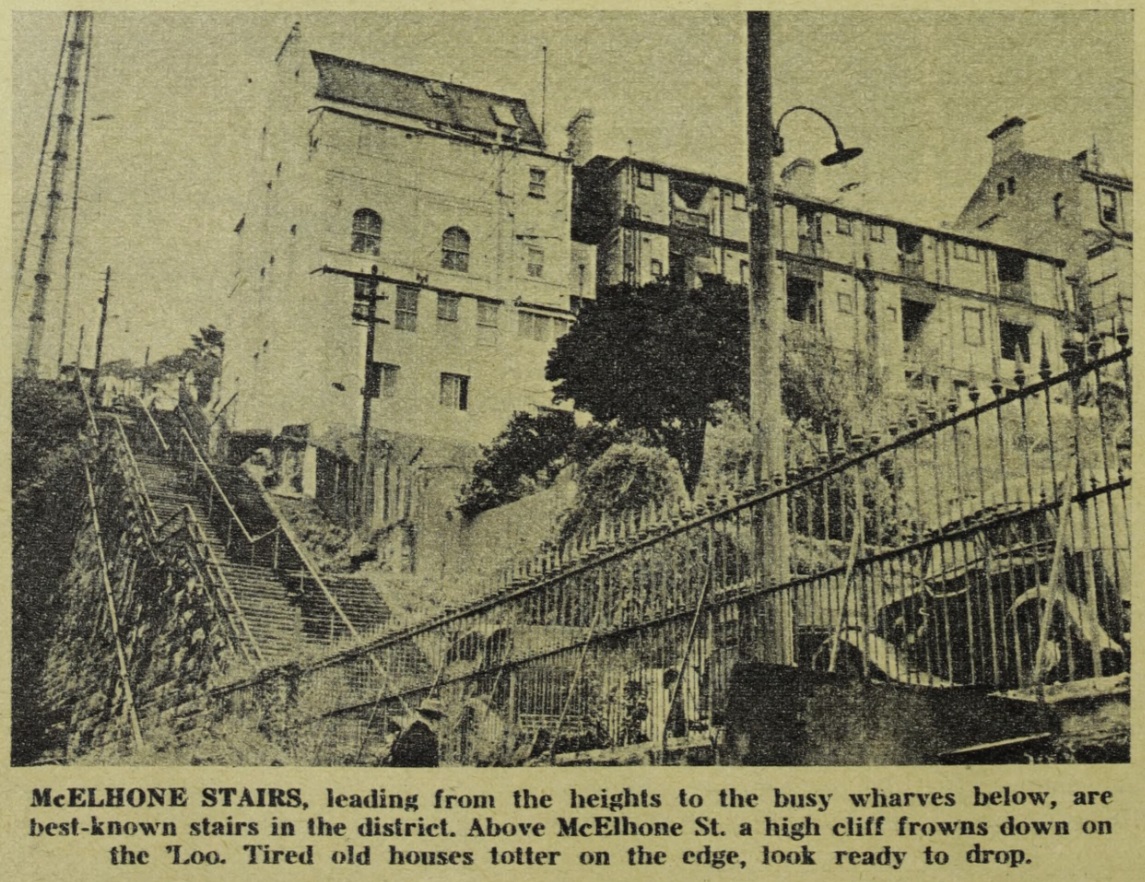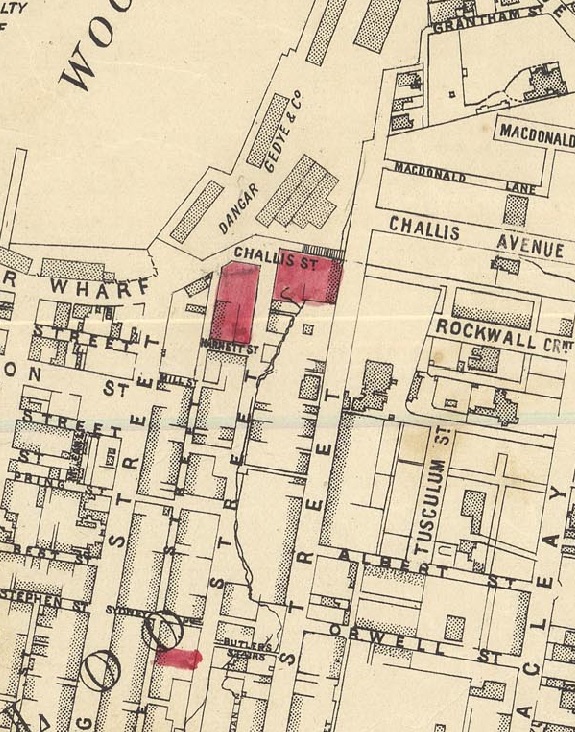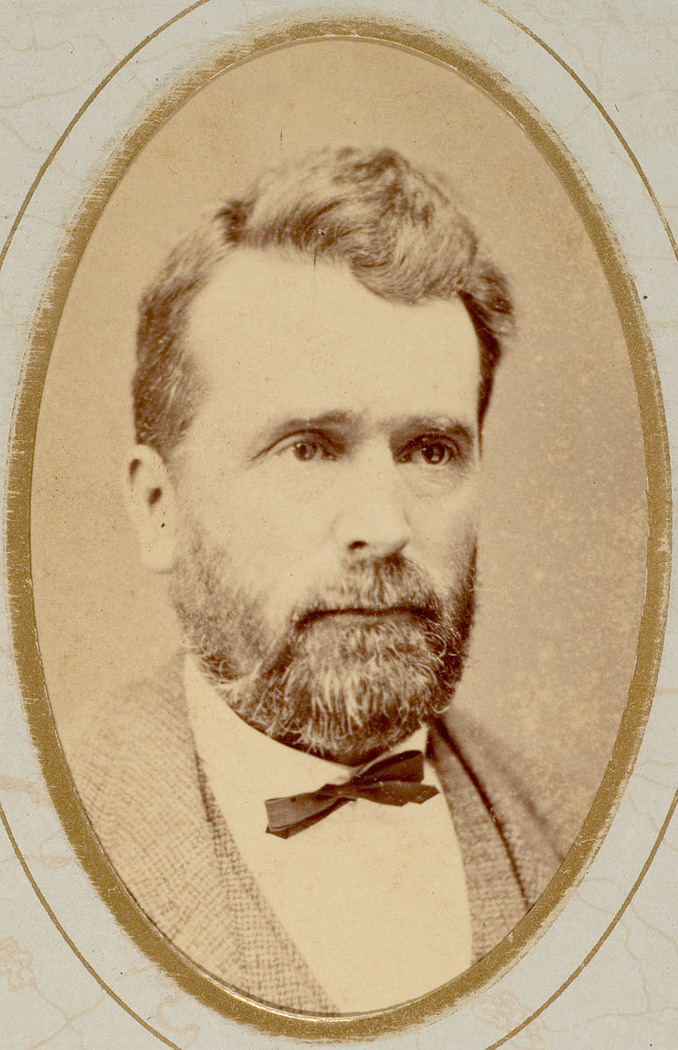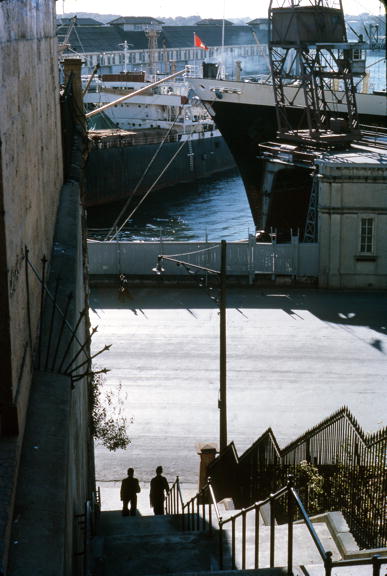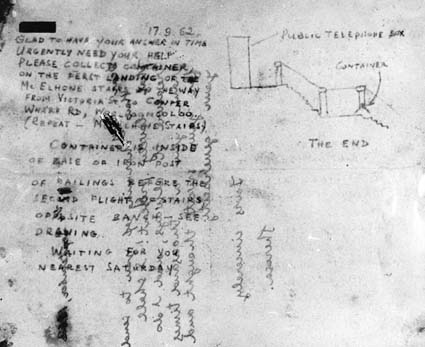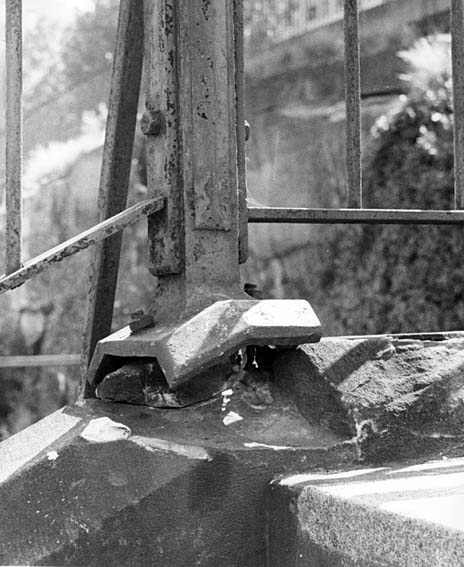The Dictionary of Sydney was archived in 2021.
McElhone Stairs
Citation
Persistent URL for this entry
To cite this entry in text
To cite this entry in a Wikipedia footnote citation
To cite this entry as a Wikipedia External link
McElhone Stairs
[media]McElhone Stairs in Woollomooloo is one of three stairways that connect Brougham Street to Victoria Street. The others are Hordern Stairs (1882) and Butler Stairs (1869).
McElhone Stairs is a large and well-used straight flight urban stairway rising over twelve metres from Brougham Street, Woolloomooloo, to Victoria Street, Potts Point. It is bounded by, and provides access to, private residences on the south side which have balconies overlooking the stairway. The Stairs consists of three flights of steps, totalling 113 risers, and creates a well-used pedestrian connection between the residences and tourist accommodation on the high ground of Victoria Street and the pubs, restaurants, wharves and the naval base of Woolloomooloo Bay and onward to the city and harbour. The straight plan form of the stairway allows from the top, a clear view corridor towards the city and the harbour.
Originally called the Challis Street Steps, they were constructed in 1904 of solid sandstone blocks which have been repaired or topped with cement and concrete in various places over time. There are two intermediate landings, approximately 3.6 metres deep by 4.2 metres wide that provide access to, and egress from, the adjoining apartment block built in 1990. The stairway has wrought iron balustrades, cast iron bollards at the top entry and a pier and lamp-post at the foot of the stairway. At the top of the stairway is Victoria Street and located to the north of the stairway a very tall sewer vent pipe, looking like the mast of a ship, creates a utilitarian landmark at the entry to the stairway.
Woolloomooloo
[media]In 1828, the Woolloomooloo hill was divided into ‘town allotments’ on the direction of Governor Darling. Each allotment was to have a high quality residence built on it and was to be set within landscaped grounds.[1] The land on which McElhone Stairs now sits formed part of the allotment granted to Dr Henry Grattan Douglass, an Irish physician, who arrived in Australia in 1821. The grant extended from Macleay Street to the shoreline of Woolloomooloo Bay.[2]
John Henry Challis owned the land by 1858.[3] When Challis died in 1889 he bequeathed a large part of his estate, including the land, to the University of Sydney.[4] In 1890 the land was ‘resumed by the crown for wharf purposes’ under The Lands for Public Purposes Acquisition Act 1880 and vested in the Minister for Public Works.[5]
The lower part of the land was vested by the Minister for Public Works in the Sydney Harbour Trust under The Sydney Harbour Trust Act 1900.[6] A footway and steps were built on part of the land along the south boundary of the Challis property, connecting Victoria Street to Brougham Street. They were completed by August 1904 when they were placed under the control of the Sydney Municipal Council.[7] They were known as Challis Street Steps and in December 1905 the area covered by the Challis Street footway and steps was dedicated as a public highway.[8]
John McElhone
[media]In 1918 it was recommended to council by the Town Clerk’s Office that ‘Challis Stairs’ be renamed McElhone Stairs and the change was approved on 10 September 1918.[9] The stairs were renamed to commemorate John McElhone, a merchant and politician who had lived in Potts Point, where he died on 6 May 1898.[10] Today the stairway still provides access from the heights of Potts Point to the wharves and the south side of the stairway still runs along what was the boundary of the original Challis estate.
Panoramic view
[media]Once created, the stairway not only provided pedestrian access between residences and workplaces or entertainment establishments but developed an energetic street life through the wide variety of users: sailors, residents, prostitutes, business people, housewives, tourists and more recently those working to increase their fitness levels. This stairway has throughout its history provided a setting for human activity. Since the building of the apartment block to the south of the stairway in 1990 the observation of the theatre of the stairway has increased as ‘[r]esidents sip tea on their balconies and stare bemusedly at the fitness freaks punishing themselves on the 113-stair uphill climb.’[11]
The panoramic view facilitated by McElhone Stairs and the wide variety of experiences encountered on them, from the arduous nature of the climb, the vibrant and colourful users, the sexual encounters and the physical dangers, have inspired writers, filmmakers and artists who have portrayed the stairway in a variety of ways.
The artist Sali Herman, who was interested in portraying the character of place, won the Wynne Prize for landscape painting with his painting of McElhone Stairs in 1944.[12] Herman saw in the stairway ‘an interesting variety of textures of paint: plaster, stone, rusty iron…the subject was the drama of a formidable staircase, how it can diminish human scale’.[13]
In 1964 John Olsen also created an image of McElhone Stairs but he did not attempt to illustrate the physical appearance of the stairway but rather the experience of ‘the urban pulse of the steps as a transitional zone where sailors, soldiers and drunks made their way to the bright lights of Kings Cross’.[14] One of Olsen’s most successful lithographs was also created from his interpretation of the painting. Whilst ‘Olsen described this print as primitive, brassy and very intoxicated, the perambulated narrative line that talks to the drunks, sailors and soldiers as it weaves its intriguing path down the steps’ evokes the movement of the festive human bodies laughing and joking as they climb or descend.[15] Olsen’s vibrant and lively works of McElhone Stairs show us the human activity and life carried out on the stairway rather than the physical reality of the stairway itself.
Various aspects of the stairway’s use have been portrayed in Australian literature including the arduous climb and its pleasures. In the 2011 novel Five Bells the author Gail Jones expresses this mix:
As she climbed the steep steps at Woolloomooloo, Catherine huffed and puffed but felt pleased with herself for the effort, and for the muscular sensuality of her working legs. Pausing on a landing, she looked briefly behind her: the centre of the city hung like a vision in a silver panorama – the towers, all arrayed, the canyons between them, the bridge in faint outline and the Opera House now obscured.[16]
The view from McElhone Stairs is one of its attractions, appreciated by film directors, writers, tourists and everyday users of the stairway. McElhone Stairs has been used as a setting in the films The Kid Stakes, and Two Hands, and in the novels such as An Angel in Australia, Archimedes and the Seagle, Five Bells and The Trout Opera.
Cold War drama
[media]McElhone Stairs was also the site of real life drama during the Cold War. The stairway was one of the sites for the espionage activities of Ivan Fedorovich Skripov, First Secretary of the Russian Embassy in Australia. In 1962 he used one of the stanchions of the stairway balustrade as a secret drop-off point to conceal an aluminium message container intended for collection by another secret operative.[17] On September 17 1962, Mr. Skripov wrote to the Agent in invisible writing instructing her to pick up and deliver to him a container which would be found concealed under an iron post of the railings of the McElhone Stairs. The agent found the container as described two days later.[18] [media]The container was recovered by ASIO agents and the photographs that they took are held in the National Archives of Australia.[19] Skripov was declared persona non grata and forced to return to Russia. The story so fascinated the Australian public that The Australian Women’s Weekly produced a magazine article in February 1963 using a staff member as a stand-in for ‘the agent’ and photographed her re-enacting the events.[20]
Notes
[1] Avryl Whitnall, Villas of Darlinghurst, Sydney: State Library of New South Wales, 2002,3.
[2] Woolloomooloo, Potts Point, original lots, copy of the govt. chart in the years 1829 [cartographic material] / by P. L. Bemi, Mitchell Library, State Library of NSW, M2 811.1811/1829/1
[3] Avryl Whitnall, Villas of Darlinghurst, Sydney: State Library of New South Wales, 2002, 5.
[4] The Sydney Morning Herald, Saturday 5 June 1880, 7; David S. Macmillan, ‘Challis, John Henry (1806– 1880)’,
[5] Government plan: Woolloomooloo Bay Resumptions - Tracing shewing Challis St - Resumed by the Crown for wharf purposes [M-CRS99] , 1 October 1895, City of Sydney Archives, G1-24/10
[6] City Engineer's Miscellaneous Books, City of Sydney Archives CRS 119/11/68
[7] Government plan: Plan of McElhone Stairs - Covered by Challis St Footway [M-CRS99] 29 August 1904, City of Sydney Archives G2-90/1
[8] Government plan: [Woolloomooloo Bay to Challis Ave including Challis Street Steps between Brougham St and Victoria Street - Potts Point] [M-CRS99] 20 June 1904 -12 December 1905, City of Sydney Archives, G1-24/1
[9] Changing of name of Challis Stairs [leading from Cowper Wharf to Victoria Street North] to McElhone Stairs, 11 Sep 1918, Town Hall Clerk's Correspondence City of Sydney Archives, 3309/18
[10] Martha Rutledge, ‘McElhone, John (1833–1898)’, Australian Dictionary of Biography, National Centre of Biography, Australian National University, http://adb.anu.edu.au/biography/mcelhone-john-4087 viewed 23 January 2018
[11] Sydney attractions: McElhone Stairs, Lonely Planet website, www.lonelyplanet.com/australia/sydney/sights/historic-site/mcelhone-stairs Viewed 6 January 2012
[12] Sali Herman, McElhone stairs 1944, National Gallery of Australia NGA 76.1083 https://artsearch.nga.gov.au/Detail.cfm?IRN=41746 viewed 23 January 2018; Daniel Thomas, Sali Herman, Sydney and London: William Collins Australia Ltd, 1971, 11
[13] Daniel Thomas, Sali Herman, Sydney and London: William Collins Australia Ltd, 1971, 20
[14] John Olsen, McElphone Steps 1964, Art Gallery of New South Wales DA9.1964, https://www.artgallery.nsw.gov.au/collection/works/DA9.1964/ viewed 23 January 2018; Peter Emmett, Sydney Metropolis Suburb Harbour, Sydney: Historic Houses Trust of New South Wales, 2000,109
[15] Ken McGregor and Jeffrey Makin, John Olsen: Teeming with Life Melbourne: Macmillan Art Publishing, 2005, 12
[16] Gail Jones, Five Bells North Sydney: Vintage Books, 2011,171
[17] Frank Cain, The Australian Security Intelligence Organization: an unofficial history, Melbourne: Spectrum Publications 1994
[18] The Naval Review, Vol.51, No.3, July 1963, 354
[19] National Archives of Australia, A432, 1963/2272
[20] The Australian Women’s Weekly, 20 February 1963,4-5, Trove http://nla.gov.au/nla.news-article47509158 viewed 23 January 2018



